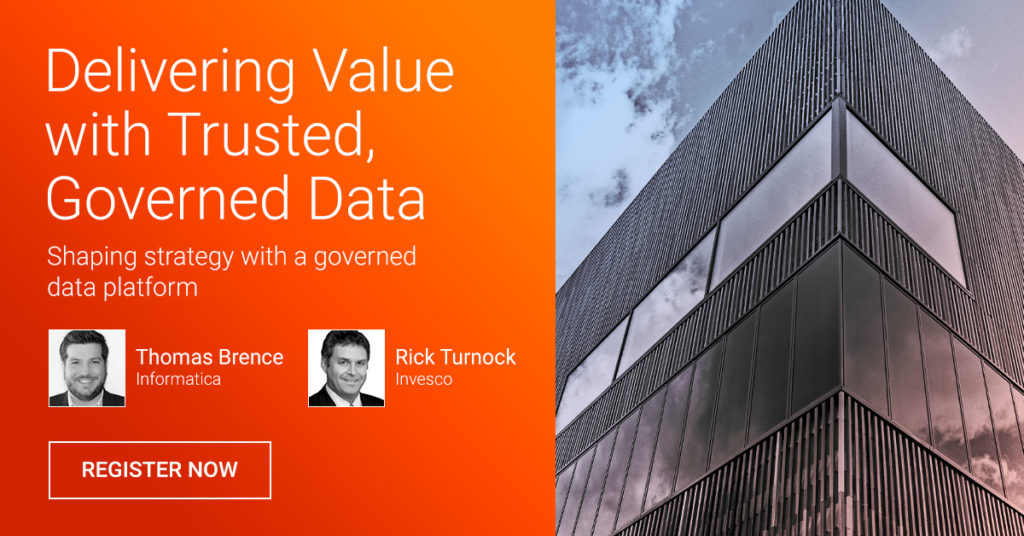Data Lakes and Data Governance Drive Better Decision-Making at Invesco
Has data ever been more important than it is right now? As the world continues to grapple with the scale and impact of COVID-19, we look to data—and more importantly, the analysis of that data—to provide us with some level of understanding. There are data sources from independent labs, healthcare systems, different countries, and all types of organizations, with each source providing its own version of an “accurate” view. The wave of data, data sources, and contradicting analyses of this information from different organizations has shown that a little governance would go a long way to providing what everyone needs—namely, trust. Keep in mind that, according to IDC, a mere 2.5% of all data is ever analyzed, which makes you wonder: are we ever really seeing the full picture?

This same challenge applies to businesses as well: when you have separate analytics teams handling huge volumes of data, from a variety of data sources, unless you have an enterprise data governance program, you are going to have conflicting views with no central source of trusted information. Many organizations are currently trying to solve this: they know that by building a foundation of trusted, governed data, their teams can quickly and easily discover the data that they need, define it, measure its quality, and democratize it through intelligence and automation for data-driven decision making.
And this is the world that we’ll explore the next episode of the Data Empowerment Experts Series. I’ll be joined by Rick Turnock, Global Head of Enterprise Data Services at Invesco, where he will share their journey to build a trusted, governed enterprise data platform. We’ll talk about their journey to establish a governed cloud data lake, and how providing quick and easy access to his analyst community was critical to power their business forward.
As with every episode, I sat down with Rick, our guest speaker on this webinar, to share his thoughts on the state of data governance. Here are his thoughts:
Question: How do you choose where to start?
Answer: The best place to begin is to develop a vision that establishes data as a strategic asset and a top priority for the company. Gaining executive buy-in for the vision and agreement in the data strategy is crucial to obtain the necessary investment to put your approach into action. At Invesco, once we had buy-in, our first initiative centered on proactively developing data governance and delivery capabilities within our investment platform transformation program.
Question: How do you maintain momentum?
Answer: We established an executive data council with cross-functional senior leadership that has ultimate responsibility for data-centered decision-making, including prioritization initiatives, resources, and funding. We balanced our long-term strategic initiatives with quick wins, such as tackling existing data inefficiencies or quality issues, that could be delivered to demonstrate value and generate traction. For us, developing a strong communication and change management plan is crucial for the success of a data governance program to drive new ways of working.
Question: How do you address scale?
Answer: There is no silver bullet to gain true enterprise scale. Our approach anchors to People, Process, and Technology, all of which are critical to achieve scale:
- People – Developing and maturing a data culture across the organization enables everyone to understand that data is a strategic asset and is everyone's responsibility.Given that almost every role touches data in some way, leveraging consistent processes, technologies, and best practices is crucial to achieve scale.
- Process – Defining strong data governance processes and establishing an enterprise approach is also imperative to deliver scale, including detailed roles and responsibilities, policies, standards, and issue resolution frameworks.
- Technology – Investing in enterprise data governance platforms is also key. If knowledge is buried in peoples’ heads or maintained in siloed spreadsheets, data dictionaries, or Visio diagrams, it will be difficult to scale. Building a consolidated enterprise data knowledge bank allows individuals across the organization to easily access and contribute to a centralized repository. Technology also enables enterprise data management capabilities needed to deliver on your data strategy.
Question: How do you measure success?
Answer: Measuring results and reporting effectively are key components of our governance program. We developed KPI dashboards for both data governance and data quality that measure our level of adoption, maturity, and key trends. Transparency is key for success: our data portal, which contains our key dashboards and metrics, is accessible to everyone across the organization. Our communication program helps keep executive stakeholders informed and engaged in the process.
Question: How has data privacy been a factor?
Answer: Given that we are a global company, data privacy has become a key initiative and focus area for our governance program. This includes understanding what Personally Identifiable Information (PII) data we have, where it is stored, how it moves throughout the organization, who is responsible, etc. The priority put on privacy reinforced the need to invest in an enterprise data governance platform.
Question: How do you empower the business to drive value?
Answer: Successful execution of an enterprise-wide data strategy and governance program that is anchored to providing quality data builds trust with the business and leads to increasing demand. Trusted data empowers the business to utilize insights to make well-informed, data-driven decisions. Prioritizing initiatives can ensure governance efforts are focused on providing the highest value to the organization.
I hope that you’ll join us on Wednesday, May 27th to learn more about Invesco’s data governance journey. Register to attend here and I’ll look forward to continuing this discussion with Rick on our webinar.









